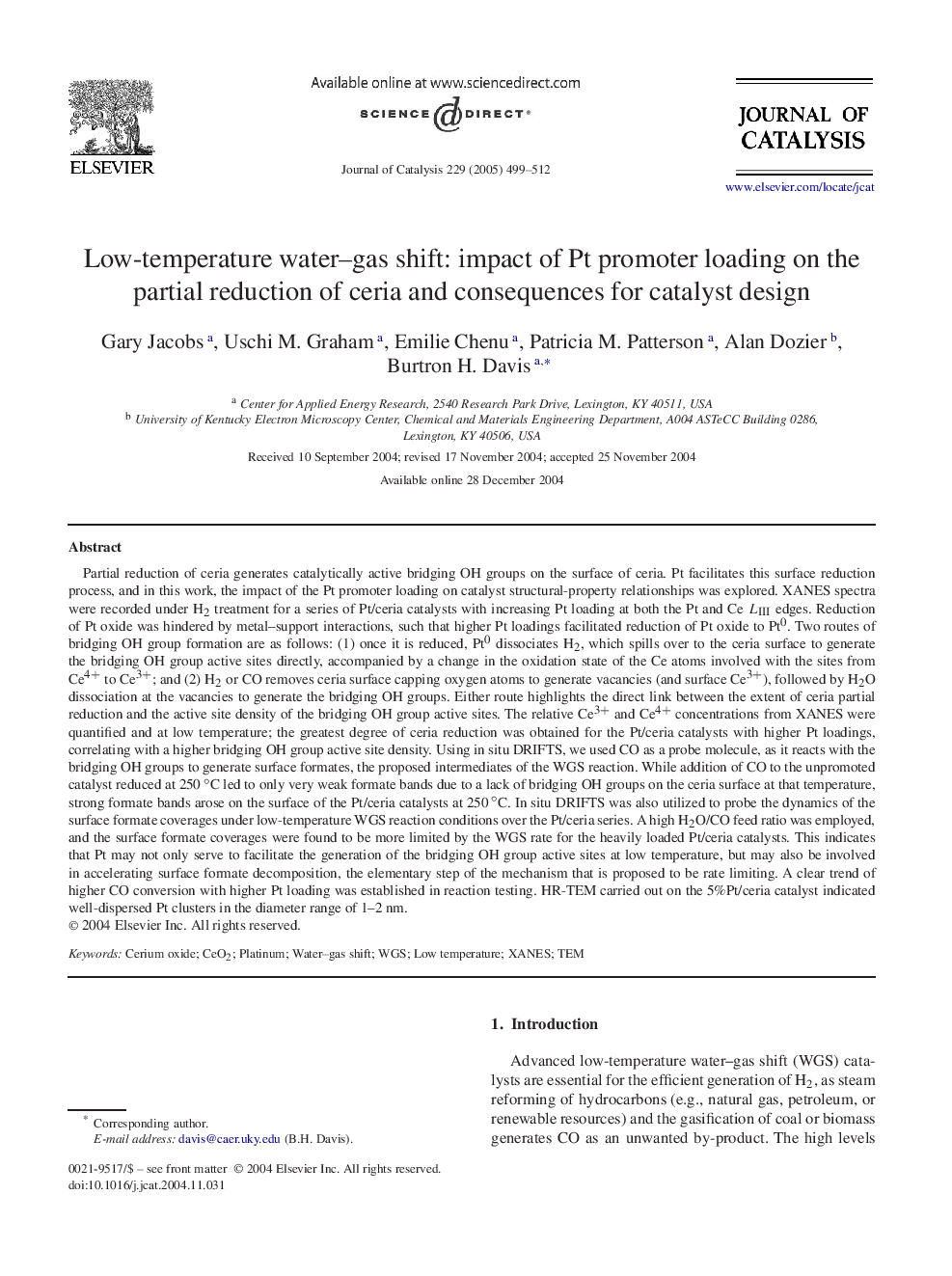| کد مقاله | کد نشریه | سال انتشار | مقاله انگلیسی | نسخه تمام متن |
|---|---|---|---|---|
| 10244815 | 47704 | 2005 | 14 صفحه PDF | دانلود رایگان |
عنوان انگلیسی مقاله ISI
Low-temperature water-gas shift: impact of Pt promoter loading on the partial reduction of ceria and consequences for catalyst design
دانلود مقاله + سفارش ترجمه
دانلود مقاله ISI انگلیسی
رایگان برای ایرانیان
کلمات کلیدی
موضوعات مرتبط
مهندسی و علوم پایه
مهندسی شیمی
کاتالیزور
پیش نمایش صفحه اول مقاله

چکیده انگلیسی
Partial reduction of ceria generates catalytically active bridging OH groups on the surface of ceria. Pt facilitates this surface reduction process, and in this work, the impact of the Pt promoter loading on catalyst structural-property relationships was explored. XANES spectra were recorded under H2 treatment for a series of Pt/ceria catalysts with increasing Pt loading at both the Pt and Ce LIII edges. Reduction of Pt oxide was hindered by metal-support interactions, such that higher Pt loadings facilitated reduction of Pt oxide to Pt0. Two routes of bridging OH group formation are as follows: (1) once it is reduced, Pt0 dissociates H2, which spills over to the ceria surface to generate the bridging OH group active sites directly, accompanied by a change in the oxidation state of the Ce atoms involved with the sites from Ce4+ to Ce3+; and (2) H2 or CO removes ceria surface capping oxygen atoms to generate vacancies (and surface Ce3+), followed by H2O dissociation at the vacancies to generate the bridging OH groups. Either route highlights the direct link between the extent of ceria partial reduction and the active site density of the bridging OH group active sites. The relative Ce3+ and Ce4+ concentrations from XANES were quantified and at low temperature; the greatest degree of ceria reduction was obtained for the Pt/ceria catalysts with higher Pt loadings, correlating with a higher bridging OH group active site density. Using in situ DRIFTS, we used CO as a probe molecule, as it reacts with the bridging OH groups to generate surface formates, the proposed intermediates of the WGS reaction. While addition of CO to the unpromoted catalyst reduced at 250â°C led to only very weak formate bands due to a lack of bridging OH groups on the ceria surface at that temperature, strong formate bands arose on the surface of the Pt/ceria catalysts at 250â°C. In situ DRIFTS was also utilized to probe the dynamics of the surface formate coverages under low-temperature WGS reaction conditions over the Pt/ceria series. A high H2O/CO feed ratio was employed, and the surface formate coverages were found to be more limited by the WGS rate for the heavily loaded Pt/ceria catalysts. This indicates that Pt may not only serve to facilitate the generation of the bridging OH group active sites at low temperature, but may also be involved in accelerating surface formate decomposition, the elementary step of the mechanism that is proposed to be rate limiting. A clear trend of higher CO conversion with higher Pt loading was established in reaction testing. HR-TEM carried out on the 5%Pt/ceria catalyst indicated well-dispersed Pt clusters in the diameter range of 1-2 nm.
ناشر
Database: Elsevier - ScienceDirect (ساینس دایرکت)
Journal: Journal of Catalysis - Volume 229, Issue 2, 25 January 2005, Pages 499-512
Journal: Journal of Catalysis - Volume 229, Issue 2, 25 January 2005, Pages 499-512
نویسندگان
Gary Jacobs, Uschi M. Graham, Emilie Chenu, Patricia M. Patterson, Alan Dozier, Burtron H. Davis,